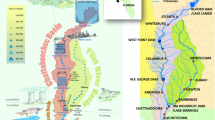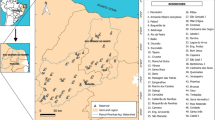Abstract
Climate change has the potential to alter the quantity and timing of runoff, which may pose significant challenges for reservoir management. One challenge is developing operating policies for an unknown and uncertain future. Here, we develop a suite of ‘optimal’ operating policies for the reservoir system of Portland, Oregon. We assess the sensitivity of projected reservoir reliability to the choice of GCMs and time periods used to develop each of our policies. Results indicate that, while different GCMs and fitting periods produce different optimal operating policies, when those policies are applied across all the other GCM scenarios, the overall projected reliability does not change due to the great variability between simulations. Across the simulations, we note a trend of decreasing reliability in the future which is not sensitive to the choice of GCM or fitting period. This indicates that the projected reliability is dominated by uncertainty in climate projections that cannot be mitigated by tuning operating policies to projected changes.










Similar content being viewed by others
References
Acharya A, Piechota TC, Tootle G (2011) Quantitative assessment of climate change impacts on the hydrology of the North Platte River watershed, Wyoming. J Hydrol Eng 17(10):1071–1083
Aguado E, Cayan D, Riddle L, Roos M (1992) Climatic fluctuations and the timing of West Coast streamflow. J Clim 5(12):1468–1483
Brekke L, Thrasher BL, Maurer EP, Pruitt T (2013) Downscaled CMIP3 and CMIP5 climate and hydrology projections: Release of downscaled CMIP5 climate projections, comparison with preceding information, and summary of user needs. US Dept. of the Interior, Bureau of Reclamation, Technical Services Center, Denver
Chang H, Praskievicz S, Parandvash H (2014) Sensitivity of urban water consumption to weather and climate variability at multiple temporal scales: The case of Portland Oregon. Int J Geospatial Environ Res 1(1):7
Chen J, Brissette FP, Leconte R (2011) Uncertainty of downscaling method in quantifying the impact of climate change on hydrology. J Hydrol 401:3–4
Chen J, Brissette FP, Chaumont D, Braun M (2013) Finding appropriate bias correction methods in downscaling precipitation for hydrologic impact studies over North America. Water Resour Res 49(7):4187–4205
Chen D, Leon AS, Engle SP, Fuentes C, Chen Q (2017) Offline training for improving online performance of a genetic algorithm based optimization model for hourly multi-reservoir operation. Environ Model Softw 96:46–57
Christensen ns, Wood AW, Voisin N, Lettenmaier DP, Palmer RN (2004) The effects of climate change on the hydrology and water resources of the Colorado River basin. Clim Change 62(1–3):337–363
Chung F, Anderson J, Arora S, Ejeta M, Galef J, Kadir T, Kao K, Olson A, Quan C, Reyes E, Roos M, Seneviratne S, Wang J, Yin H, Blomquist N (2009) Using Future Climate Projections to Support Water Resources Decision Making in California. PIER Research Report, California Energy Commission
Das T, Hidalgo HG, Pierce DW, Barnett TP, Dettinger MD, Cayan DR, Bonfils C, Bala G, Mirin A (2009) Structure and detectability of trends in hydrological measures over the western United States. J Hydrometeorol 10(4):871–892
Dettinger MD, Cayan DR (1995) Large-scale atmospheric forcing of recent trends toward early snowmelt runoff in California. J Clim 8(3):606–623
Dettinger MD, Cayan DR, Meyer MK, Jeton AE (2004) Simulated hydrologic responses to climate variations and change in the Merced, Carson, and American River basins, Sierra Nevada, California, 1900–2099. Climatic Change 62(1–3):283–317
Dickerson-Lange SE, Mitchell R (2014) "Modeling the effects of climate change projections on streamflow in the Nooksack River basin. Northwest Washington” Hydrological Processes 28(20):5236–5250
Eisel LM (1972) “Chance constrained reservoir model”. Water Resour Res 8(2):339–347
Fowler HJ, Ekström M (2009) Multi-model ensemble estimates of climate change impacts on UK seasonal precipitation extremes. Int J Climatol 29(3):385–416
Fritze H, Stewart IT, Pebesma E (2011) Shifts in western North American snowmelt runoff regimes for the recent warm decades. J Hydrometeorol 12(5):989–1006
Giuntoli I, Villarini G, Prudhomme C, Hannah DM (2018) Uncertainties in projected runoff over the conterminous United States. Clim Change 150:3–4
Hamlet AF (2011) Assessing water resources adaptive capacity to climate change impacts in the Pacific Northwest Region of North America. Hydrol Earth Syst Sci 15(5):1427
Hamlet AF, Lettenmaier DP (2007) Effects of 20th century warming and climate variability on flood risk in the western US. Water Resour Res 43:6
Harding BL, Wood AW, Prairie JR (2012) The implications of climate change scenario selection for future streamflow projection in the Upper Colorado River Basin. Hydrol Earth Syst Sci 16(11):3989–4007
Heino J, Virkkala R, Toivonen H (2009) Climate change and freshwater biodiversity: detected patterns, future trends and adaptations in northern regions. Biol Rev 84(1):39–54
Herman JD, Giuliani M (2018) Policy tree optimization for threshold-based water resources management over multiple timescales. Environ Model Softw 99:39–51
Horton P, Schaefli B, Mezghani A, Hingray B, Musy A (2006) Assessment of climate-change impacts on alpine discharge regimes with climate model uncertainty. Hydrol Process 20(10):2091–2109
Huntington TG, Billmire M (2014) Trends in precipitation, runoff, and evapotranspiration for rivers draining to the Gulf of Maine in the United States. J Hydrometeorol 15(2):726–743
Karamouz M, Houck MH (1982) Annual and monthly reservoir operating rules generated by deterministic optimization. Water Resour Res 18(5):1337–1344
Kay AL, Davies HN, Bell VA, Jones RG (2009) Comparison of uncertainty sources for climate change impacts: flood frequency in England. Clim Change 92:1–2
Lakew HB, Moges SA, Asfaw DH (2017) Hydrological evaluation of satellite and reanalysis precipitation products in the Upper Blue Nile Basin: A case study of Gilgel Abbay. Hydrology 4(3):39
Lee S-Y, Hamlet AF, Fitzgerald CJ, Burges SJ (2009) Optimized flood control in the Columbia River Basin for a global warming scenario. J Water Resour Plan Manag 135(6):440–450
Liang Xu, Lettenmaier DP, Wood EF, Burges SJ (1994) A simple hydrologically based model of land surface water and energy fluxes for general circulation models. J Geophys Res Atmos 99(D7):14415–14428
Lopez A, Fung F, New M, Watts G, Weston A, Wilby RL (2009) From climate model ensembles to climate change impacts and adaptation: A case study of water resource management in the southwest of England. Water Resour Res 45:8
Loucks DP (1970) Some comments on linear decision rules and chance constraints. Water Resour Res 6(2):668–671
Luce CH, Holden ZA (2009) Declining annual streamflow distributions in the Pacific Northwest United States, 1948–2006. Geophys Res Lett 36(16):L16401
Lundquist JD, Dettinger MD, IT Stewart, DR Cayan (2009) Variability and trends in spring runoff in the western United States. Climate warming in western North America: evidence and environmental effects. University of Utah Press, Salt Lake City, pp 63–76
Maurer EP, Wood AW, Adam JC, Lettenmaier DP, Nijssen B (2002) A long-term hydrologically based dataset of land surface fluxes and states for the conterminous United States. J Clim 15(22):3237–3251
Maurer EP, Brekke L, Pruitt T, Duffy PB (2007) Fine-resolution climate projections enhance regional climate change impact studies. Eos Transactions American Geophysical Union 88(47):504–504
McCabe GJ, Clark MP (2005) Trends and variability in snowmelt runoff in the western United States. J Hydrometeorol 6(4):476–482
McMahon TA, Adeloye AJ, Zhou Sen-Lin (2006) Understanding performance measures of reservoirs. J Hydrol 324:1–4
Mereu S, Sušnik J, Trabucco A, Daccache A, Vamvakeridou-Lyroudia L, Renoldi S, Virdis A, Savić D, Assimacopoulos D (2016) Operational resilience of reservoirs to climate change, agricultural demand, and tourism: a case study from Sardinia. Sci Total Environ 543:1028–1038
Mote PW (2006) Climate-driven variability and trends in mountain snowpack in western North America. J Clim 19(23):6209–6220
Nayak A, Marks D, Chandler DG, Seyfried M (2010) Long-term snow, climate, and streamflow trends at the Reynolds Creek experimental watershed, Owyhee Mountains, Idaho, United States. Water Resour Res 46(6):W06519
Nover DM, Witt JW, Butcher JB, Johnson TE, Weaver CP (2016) The effects of downscaling method on the variability of simulated watershed response to climate change in five us basins. Earth Interact 20(11):1–27
IPCC (2014) Climate change 2014: synthesis report. Contribution of Working Groups I, II and III to the Fifth Assessment Report of the Intergovernmental Panel on Climate Change [Core Writing Team, R.K. Pachauri and L.A. Meyer (eds.)]. IPCC, Geneva, Switzerland, pp 151
Pierce DW, Cayan DR, Das T, Maurer EP, Miller NL, Bao Y, Kanamitsu M et al (2013) The key role of heavy precipitation events in climate model disagreements of future annual precipitation changes in California. J Clim 26(16):5879–5896
Polade SD, Gershunov A, Cayan DR, Dettinger MD, Pierce DW (2017) Precipitation in a warming world: Assessing projected hydro-climate changes in California and other Mediterranean climate regions. Sci Rep 7(1):10783
Prudhomme C, Davies H (2009) Assessing uncertainties in climate change impact analyses on the river flow regimes in the UK. Part 2: future climate. Clim Change 93:1–2
Regonda S, Kumar B, Rajagopalan M, Clark (2005) and John Pitlick. “Seasonal cycle shifts in hydroclimatology over the western United States. J Clim 18(2):372–384
Rowell DP (2006) A demonstration of the uncertainty in projections of UK climate change resulting from regional model formulation. Clim Change 79:3–4
Stagge JH, Glenn E, Moglen (2017) Water Resources Adaptation to Climate and Demand Change in the Potomac River. J Hydrol Eng 22(11):04017050
Stakhiv EZ, Werick W, Robert W, Brumbaugh RW (2016) Evolution of drought management policies and practices in the United States. Water Policy 18:122–152
Stewart IT, Cayan DR, Dettinger MD (2004) Changes in snowmelt runoff timing in western North America under abusiness as usual’climate change scenario. Clim Change 62:1–3
Stewart IT, Cayan DR, Dettinger MD (2005) Changes toward earlier streamflow timing across western North America. J Clim 18(8):1136–1155
Stocker TF, Qin D, Plattner GK, Tignor M, Allen SK, Boschung J, Nauels A, Xia Y, Bex V, Midgley PM (2013) Climate change 2013: the physical science basis. Intergovernmental panel on climate change, working group I contribution to the IPCC fifth assessment report (AR5). New York
Teutschbein C, Wetterhall F, Seibert J (2011) Evaluation of different downscaling techniques for hydrological climate-change impact studies at the catchment scale. Clim Dyn 37:9–10
Wang Xiao-jun, Zhang Jian-yun, Shahid S, Guan En-hong, Wu Yong-xiang, Juan Gao J, He Rui-min (2016) Adaptation to climate change impacts on water demand. Mitig Adapt Strat Glob Change 21(1):81–99
Wilby RL, Harris I (2006) A framework for assessing uncertainties in climate change impacts: Low-flow scenarios for the River Thames, UK. Water Resour Res 42(2):W02419
Woldemeskel FM, Sharma A, Sivakumar B, Mehrotra R (2016) Quantification of precipitation and temperature uncertainties simulated by CMIP3 and CMIP5 models. Journal of Geophysical Research: Atmospheres 121(1):3–17
Wood AW, Maurer EP, Kumar A, Lettenmaier DP (2002) Long-range experimental hydrologic forecasting for the eastern United States. J Geophys Res Atmos 107:D20
Zhou Y, Guo S, Liu P, Xu Chong-yu, Zhao X (2016) “Derivation of water and power operating rules for multi-reservoirs”. Hydrol Sci J 61(2):359–370
Acknowledgements
This research was sponsored by the Urban Resilience to Extremes Sustainability Research Network (UREx SRN) under National Science Foundation (NSF) grant AGS‐1444755.
Author information
Authors and Affiliations
Corresponding author
Additional information
Publisher's Note
Springer Nature remains neutral with regard to jurisdictional claims in published maps and institutional affiliations.
Rights and permissions
About this article
Cite this article
Fayaz, N., Condon, L.E. & Chandler, D.G. Evaluating the Sensitivity of Projected Reservoir Reliability to the Choice of Climate Projection: A Case Study of Bull Run Watershed, Portland, Oregon. Water Resour Manage 34, 1991–2009 (2020). https://doi.org/10.1007/s11269-020-02542-3
Received:
Accepted:
Published:
Issue Date:
DOI: https://doi.org/10.1007/s11269-020-02542-3




